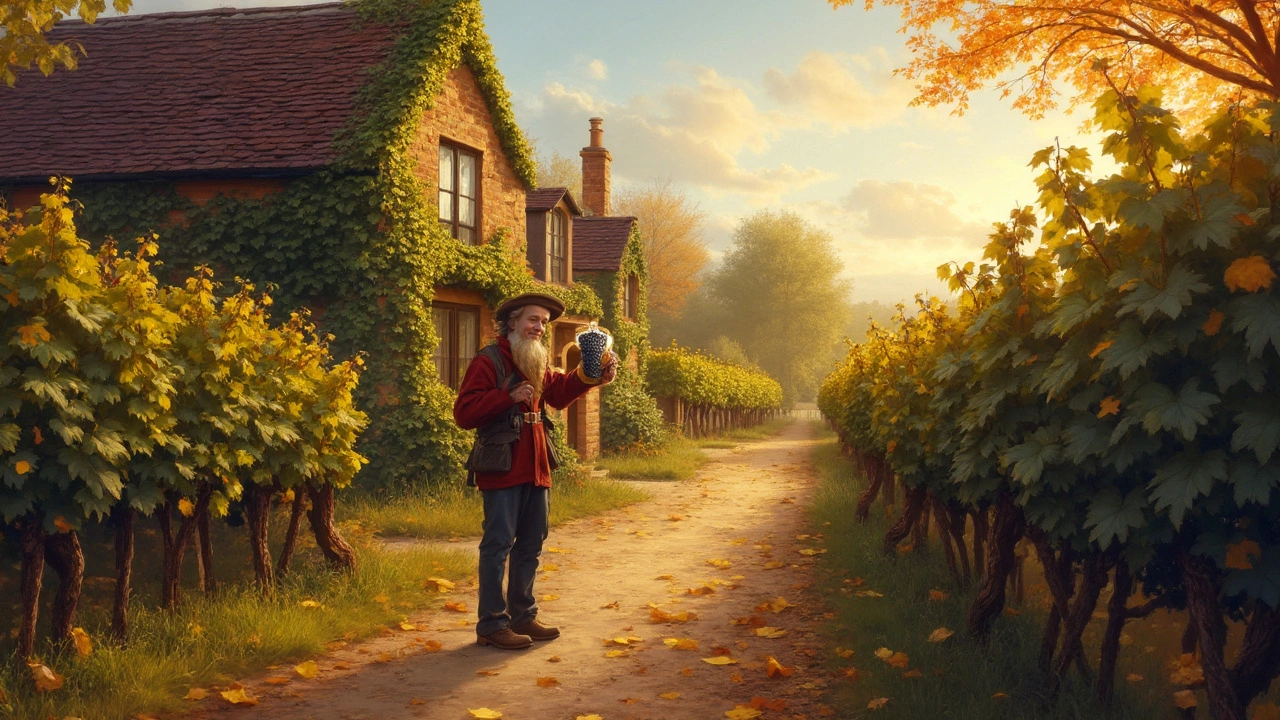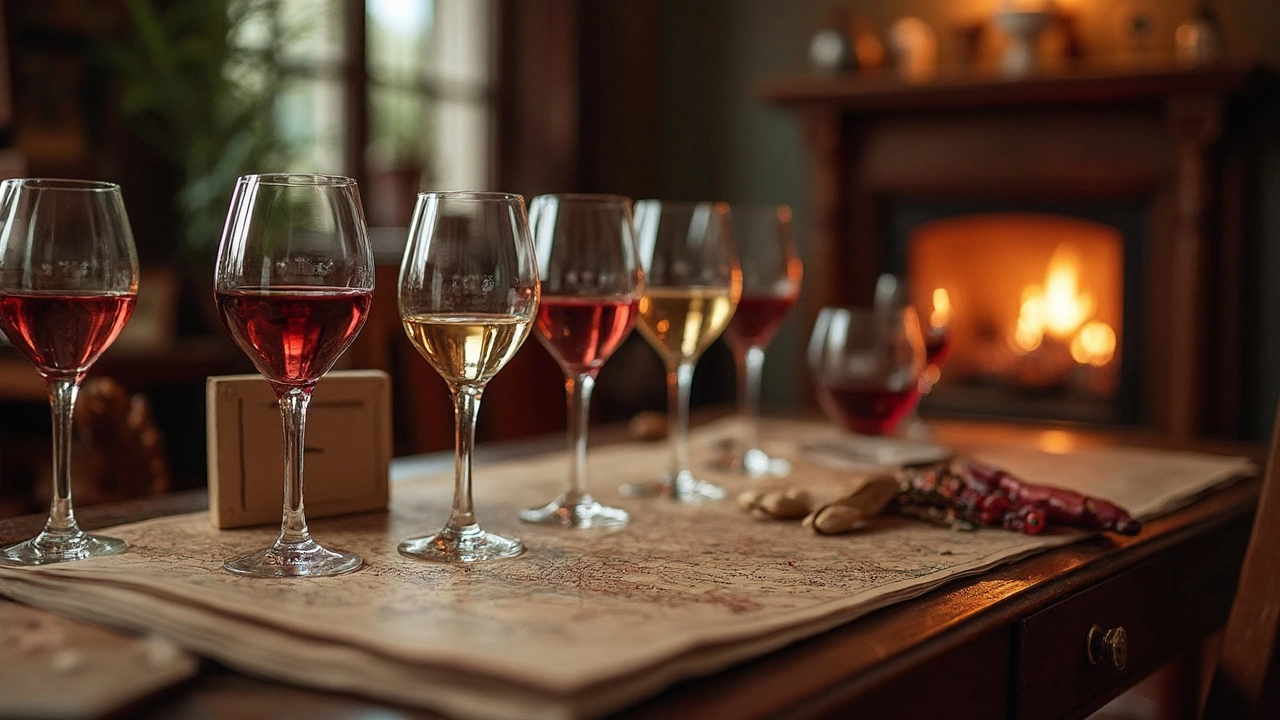The Real Deal: What's Wine Tasting All About?
 Feb, 25 2025
Feb, 25 2025
Ever wondered why people make such a fuss about wine tasting? Well, it's not just about sipping and looking fancy. It's a whole experience that involves your senses – and yes, there's an art to it. Wine tasting is about understanding the complexities of flavors, getting a whiff of history in every glass, and appreciating the journey from grape to bottle. It's a pretty cool way to wrap your head around different cultures too.
Wine tasting starts with the eyes. Yup, you gotta look before you leap. Swirl your glass and see how the wine dances. Then you give it a sniff – this isn't just for show. Your nose picks up more smells than your tongue can taste flavors, so this step is super important.
And then, the part you've been waiting for – the sip. But it doesn't end there. Notice the flavors, the feel, and even the aftertaste. Each wine tells a story, and it's up to you to ask the right questions: Is it fruity or earthy? Spicy or floral? It’s like a little detective work in each glass!
- Understanding the Basics
- The Art of Swirling and Sniffing
- Tasting Techniques and Tips
- Beyond the Glass – What It All Means
Understanding the Basics
Before diving headfirst into wine tasting, it's good to get a grip on the basics. Think of it as getting acquainted with your new favorite hobby! Wine tasting can be a bit intimidating at first, but once you break it down, it's quite approachable.
What's in a Glass?
First off, every glass of wine is a blend of flavors, aromas, and histories. It's not just fermented grape juice—it's a sensory experience. The basic components of wine include acidity, alcohol content, sweetness, tannins, and of course, flavors that vary from fruity to malty.
- Acidity: This is what makes a wine crisp and tart. Think of the zing in a chilled glass of Pinot Grigio.
- Alcohol: Adds warmth and body. Higher alcohol wines may feel heavier.
- Sweetness: Not all wines are dry. Sweetness can range from subtle to syrupy, like in some delectable dessert wines.
- Tannins: These are mostly found in red wines and give that dry, puckery feeling.
The Grape Variety
Each wine is made from specific grape varieties, with popular ones like Cabernet Sauvignon or Chardonnay. The choice of grape impacts the taste, aroma, and color, which is key to wine tasting. It’s like choosing between apples for a pie—you'll notice the difference, trust me.
Old World vs. New World
Another fundamental distinction is between Old World and New World wines. Old World wines are from traditional wine-growing regions like France and Italy. They're typically earthy and subtle. On the flip side, New World wines, particularly from areas like Australia and California, are known for being bolder and fruitier.
Knowing these basics isn't just about sounding smart at dinner parties. It provides a framework for your wine experiences and helps you articulate what you like or don’t like. So, whether you're enjoying a quiet glass at home or going all out at a wine tasting event, understanding these elements adds depth to every sip.
The Art of Swirling and Sniffing
Alright, so you're holding a glass of wine and wondering why everyone's twirling it like they’re casting spells. The big secret? Swirling helps oxygen mix with the wine, which opens up its aromas and gives you a better sniffing experience. It’s like a mini chemistry experiment in your hand.
Swirling might look fancy, but it's all about practicality. By moving the wine around, you increase its surface area and allow the subtle scents to become more prominent. Over 80% of what we 'taste' is actually from our sense of smell, so this step's crucial.
"Good wine is a necessity of life for me," wrote Thomas Jefferson. Indeed, understanding wine through swirling and sniffing makes tasting a necessity, too.
Now, on to sniffing. Why the nose game? Because the wine flavors found in the aromas are waiting to be discovered. Take a gentle but thorough sniff in three parts:
- Place your nose just above the glass and take a brief inhale to get an initial impression.
- Swirl the glass gently again and inhale a second time. This exposes different aroma layers.
- Think about what you're smelling. Is it fruity, earthy, floral? This is where your sensory journey truly kicks off.
One cool trick? Use the 'short sniff and long sniff' method. The quick sniffs help detect fruit and floral notes, while a long one might bring out more complex elements like oak or spice.
When swirling and sniffing, you're not just being pretentious. It's a practical way to dig deeper into the wine experience, to catch what the winemaker's crafted over months or even years.
| Common Aromas | Examples |
|---|---|
| Fruity | Berry, Apple, Citrus |
| Floral | Rose, Violet, Lavender |
| Spicy | Clove, Cinnamon, Pepper |
| Earthy | Mushroom, Leather, Wet soil |
Once you get the hang of swirling and sniffing, you'll see it’s not just about wine tasting; it’s embracing a fuller, richer experience of what’s in your glass.

Tasting Techniques and Tips
Diving into the world of wine tasting can seem like an artful (and slightly intimidating) affair, but it doesn't have to be a mystery. Let's break down some handy techniques and tips that can elevate your experience.
Look, Swirl, and Smell
Start with a good look at the wine. Check out its color and clarity by holding it up to the light. These visuals can clue you into the wine's age and quality. Then, give it a swirl. This isn't just for show; it helps release the wine's aromas, setting the stage for the sniffing part. Take a good sniff. You want to identify different aromas – maybe you catch a whiff of berries or a hint of vanilla.
Sipping with Purpose
When you finally take a sip, let the wine coat your palate. Think about the flavors – maybe it's citrusy or has a smoky touch. Notice the 'mouthfeel' too, like whether it's silky or rough around the edges. And how about that finish? Some wines leave their mark long after they've gone down.
Use the Spit Bucket
Spitting isn't rude in wine tasting circles; in fact, it's highly advisable when you’re tasting several kinds of wine. It helps you stay sharp and appreciate each wine without getting tipsy too quickly.
Practice Patience
Don't rush it. Take your time to appreciate the wine. Give yourself permission to linger over each step.
Record Your Thoughts
Keep notes on what you like or dislike about each wine. This can be super helpful when picking out wines later, and it helps you track your evolving tastes.
These simple techniques and tips can turn a casual glass of wine into a deeper journey into understanding and appreciating the flavors and stories behind each bottle.
Beyond the Glass – What It All Means
You may think wine tasting ends with the last sip. But, oh, there's so much more behind the scenes. Tasting goes beyond flavors; it's like a passport to different worlds. Each glass you sip can introduce you to a region, a climate, or even a year in history. It's where culture meets science.
Embracing the Culture
Wine is more than just fermented grapes; it's a piece of history from its place of origin. Knowing a wine's background can change how you perceive its taste. Wines from France might tell tales of old-world traditions, while those from Australia might show off new-world innovation. It's the mix of cultures that makes each tasting session a learning experience.
The Science Bit
Ever wondered why some wines taste so different even if they're made from the same grape? It’s all about terroir—that fancy term meaning the environment where the grapes grow. Factors like climate, soil, and even how sunny a place is can make two wines worlds apart. When tasting, you're actually experiencing a bit of that science.
Connecting with People
And don’t forget the social side of things. Wine tasting is often a shared activity, making it a great way to connect with others. Whether it's chatting with a sommelier who shares cool facts or clinking glasses with friends, it turns into a collective memory.
Navigating the Market
Understanding wine doesn't just make you sound sophisticated; it helps you make informed decisions. Ever stood in a wine aisle feeling lost? Tasting skills equip you to choose wines that suit your palate and your price range. You’ll start to recognize which wine flavors hit the right note for you.
So, next time you find yourself swirling a glass, remember you're not just tasting wine. You're experiencing a world of stories, science, and connections, one sip at a time.